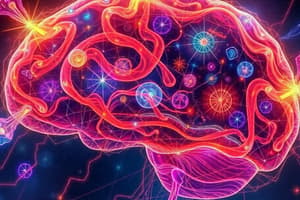Podcast
Questions and Answers
What is histology primarily concerned with studying?
What is histology primarily concerned with studying?
- Chemical composition of brain cells
- Psychological behavior of individuals
- Electrophysiological activities of neurons
- Microscopic structures and tissues (correct)
Which staining method is used for a detailed structural analysis of single cells?
Which staining method is used for a detailed structural analysis of single cells?
- Horseradish Peroxidase
- Myelin Stain
- Nissl Stain
- Golgi Silver Stain (correct)
What does the term 'autopsy' signify in the context of physiological psychology?
What does the term 'autopsy' signify in the context of physiological psychology?
- Analysis of emotional responses
- Viewing the nervous system structures after death (correct)
- Real-time imaging of brain activities
- Experimental testing of brain functions
Which neuroimaging technique was invented first in 1972?
Which neuroimaging technique was invented first in 1972?
What is the primary purpose of a myelin stain in histological studies?
What is the primary purpose of a myelin stain in histological studies?
Which imaging technique allows observation of the brain while engaging in tasks such as reading or emotional response?
Which imaging technique allows observation of the brain while engaging in tasks such as reading or emotional response?
Who were the inventors of Computerized Tomography (CT)?
Who were the inventors of Computerized Tomography (CT)?
What does Horseradish Peroxidase specifically trace in neurological studies?
What does Horseradish Peroxidase specifically trace in neurological studies?
Study Notes
Histology
- Histology is the examination of microscopic structures and tissues in detail.
- Anton van Leeuwenhoek made the first observations of nerve tissue under a microscope in 1674.
- A microtome is a device similar to a meat slicer, used for creating thin tissue sections for microscopic analysis.
Specialized Stains in Histology
- Golgi Silver Stain: Developed by Camillo Golgi; enables detailed structural analysis of individual cells.
- Nissl Stain: Highlights clusters of cell bodies, providing insight into the composition of nerve tissue.
- Myelin Stain: Traces pathways in the nervous system by staining the myelin sheath that encases nerve fibers.
- Horseradish Peroxidase: Utilized for tracing neural pathways, particularly from the thalamus.
Autopsy
- Autopsy involves examining the structure of the nervous system after death.
- The term "autopsy" translates to “to view for oneself,” emphasizing firsthand observation.
Neuroimaging
- Neuroimaging techniques allow researchers to observe the living brain during various activities, replacing the need for autopsy.
- Computerized Tomography (CT): Invented in 1972 by Godfrey Hounsfield and Allan Cormack; offers the initial high-resolution images of living brains. CT creates detailed three-dimensional representations.
- Positron Emission Tomography (PET): Utilizes gamma cameras to detect radiation from radioactive decay; it visualizes metabolic processes in the brain.
- Magnetic Resonance Imaging (MRI): A fundamental medical diagnostic tool used for disease detection, pioneered by Raymond Damadian, Larry Minkoff, and Michael Goldsmith in 1977.
- Functional MRI (fMRI): Assesses brain activity by tracking blood flow; first conducted by Belliveau et al. in 1991. William James noted the significance of blood flow observations by Angelo Mosso in the 19th century.
- Electroencephalogram (EEG): Measures the brain's electrical activity through scalp electrodes; first recordings were made by Hans Berger in 1924.
Studying That Suits You
Use AI to generate personalized quizzes and flashcards to suit your learning preferences.
Description
This quiz explores various research methods and approaches in the field of physiological psychology, focusing on histology and its significance. It includes historical references and the use of specialized stains for examining nerve tissue. Enhance your understanding of how these techniques contribute to psychological research.




